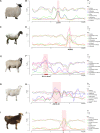Deep Genome Resequencing Reveals Artificial and Natural Selection for Visual Deterioration, Plateau Adaptability and High Prolificacy in Chinese Domestic Sheep
- PMID: 31001329
- PMCID: PMC6454055
- DOI: 10.3389/fgene.2019.00300
Deep Genome Resequencing Reveals Artificial and Natural Selection for Visual Deterioration, Plateau Adaptability and High Prolificacy in Chinese Domestic Sheep
Abstract
Sheep were one of the earliest domesticated animals. Both artificial and natural selection during domestication has resulted in remarkable changes in behavioral, physiological, and morphological phenotypes; however, the genetic mechanisms underpinning these changes remain unclear, particularly for indigenous Chinese sheep. In the present study, we performed pooled whole-genome resequencing of 338 sheep from five breeds representative of indigenous Chinese breeds and compared them to the wild ancestors of domestic sheep (Asian mouflon, Ovis orientalis) for detection of genome-wide selective sweeps. Comparative genomic analysis between domestic sheep and Asian mouflon showed that selected regions were enriched for genes involved in bone morphogenesis, growth regulation, and embryonic and neural development in domestic sheep. Moreover, we identified several vision-associated genes with funtional mutations, such as PDE6B (c.G2994C/p.A982P and c.C2284A/p.L762M mutations), PANK2, and FOXC1/GMSD in all five Chinese native breeds. Breed-specific selected regions were determined including genes such as CYP17 for hypoxia adaptability in Tibetan sheep and DNAJB5 for heat tolerance in Duolang sheep. Our findings provide insights into the genetic mechanisms underlying important phenotypic changes that have occurred during sheep domestication and subsequent selection.
Keywords: adaptability; domestication; sheep; vision; whole-genome resequencing.
Figures




Similar articles
-
Whole-genome resequencing reveals molecular imprints of anthropogenic and natural selection in wild and domesticated sheep.Zool Res. 2022 Sep 18;43(5):695-705. doi: 10.24272/j.issn.2095-8137.2022.124. Zool Res. 2022. PMID: 35843722 Free PMC article.
-
Genome-wide analysis reveals population structure and selection in Chinese indigenous sheep breeds.BMC Genomics. 2015 Mar 17;16(1):194. doi: 10.1186/s12864-015-1384-9. BMC Genomics. 2015. PMID: 25888314 Free PMC article.
-
Selection signature analysis reveals RDH5 performed key function in vision during sheep domestication process.Arch Anim Breed. 2023 Feb 23;66(1):81-91. doi: 10.5194/aab-66-81-2023. eCollection 2023. Arch Anim Breed. 2023. PMID: 37384328 Free PMC article.
-
Phenotype transition from wild mouflon to domestic sheep.Genet Sel Evol. 2024 Jan 2;56(1):1. doi: 10.1186/s12711-023-00871-6. Genet Sel Evol. 2024. PMID: 38166592 Free PMC article. Review.
-
Whole-Genome Resequencing in Sheep: Applications in Breeding, Evolution, and Conservation.Genes (Basel). 2025 Mar 22;16(4):363. doi: 10.3390/genes16040363. Genes (Basel). 2025. PMID: 40282323 Free PMC article. Review.
Cited by
-
Leveraging Whole-Genome Resequencing to Uncover Genetic Diversity and Promote Conservation Strategies for Ruminants in Asia.Animals (Basel). 2025 Mar 13;15(6):831. doi: 10.3390/ani15060831. Animals (Basel). 2025. PMID: 40150358 Free PMC article. Review.
-
Genomic, Transcriptomic and Epigenomic Tools to Study the Domestication of Plants and Animals: A Field Guide for Beginners.Front Genet. 2020 Jul 15;11:742. doi: 10.3389/fgene.2020.00742. eCollection 2020. Front Genet. 2020. PMID: 32760427 Free PMC article. Review.
-
Genetic diversity, population structure, and selective signature of sheep in the northeastern Tarim Basin.Front Genet. 2023 Nov 9;14:1281601. doi: 10.3389/fgene.2023.1281601. eCollection 2023. Front Genet. 2023. PMID: 38028584 Free PMC article.
-
The genetic characterization of germplasm and identification of the litter size trait associated candidate genes in Dexin mutton and fine-wool sheep.Front Genet. 2024 Aug 14;15:1457634. doi: 10.3389/fgene.2024.1457634. eCollection 2024. Front Genet. 2024. PMID: 39211736 Free PMC article.
-
Whole genome sequencing of Luxi Black Head sheep for screening selection signatures associated with important traits.Anim Biosci. 2022 Sep;35(9):1340-1350. doi: 10.5713/ab.21.0533. Epub 2022 Apr 30. Anim Biosci. 2022. PMID: 35507856 Free PMC article.
References
-
- Axenovich T., Zorkoltseva I., Belonogova N., van Koolwijk L. M., Borodin P., Kirichenko A., et al. (2011). Linkage and association analyses of glaucoma related traits in a large pedigree from a Dutch genetically isolated population. J. Med. Genet. 48 802–809. 10.1136/jmedgenet-2011-100436 - DOI - PubMed
LinkOut - more resources
Full Text Sources

